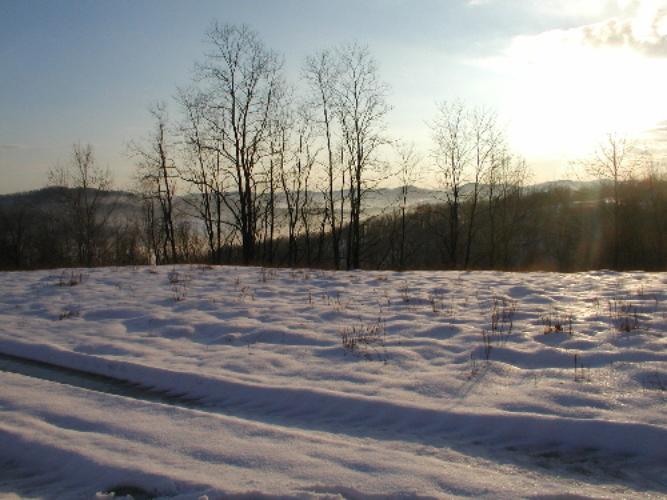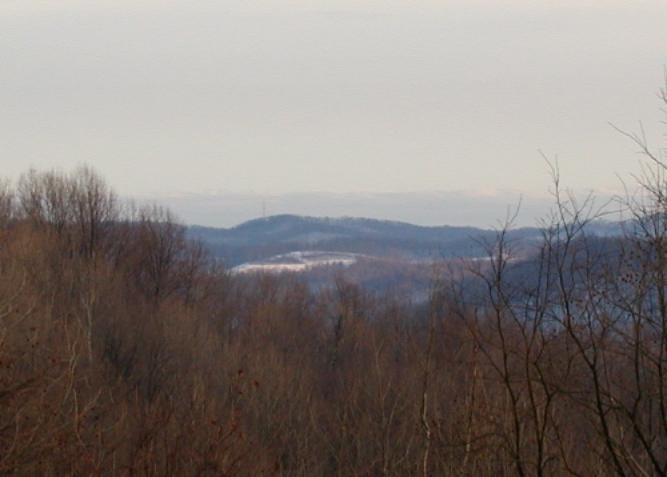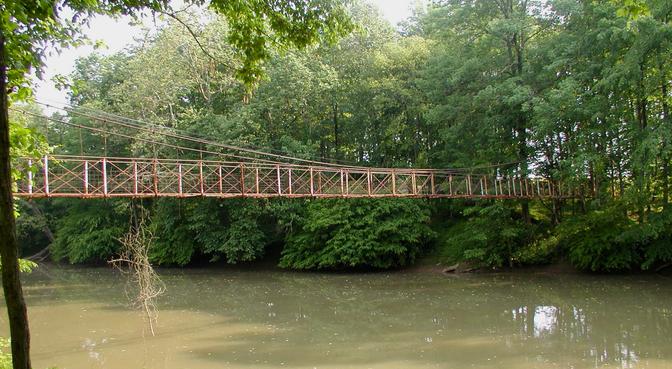
| Next Chapter | Previous Chapter | |
| Chapter 26: Nostalgia: 2. Blackberries | Contents | Chapter 24: Danger from Animals |
When I began farming, water for the cattle was obtained entirely from streams. The farm at Lost Creek was reasonably well watered, but the old folks were familiar with droughts. The fact that the farm ran on the other side of the road and included Lost Creek across from Aunt Lotta's house was impressed on me: you could run the cattle across the road to let them drink, the way they did in the drought of 1930's. At this writing, in 2000, that seems strange, with all the automobile and truck traffic, and the polluted water. It is hard to remember that the Lost Creek-West Milford road was once a dirt road with little traffic.
My grandfather, T. M. Bond, loved roses and grew them along the road. I have heard older folks tell that he would go out to work with them, and travelers would come along and stop to talk to him, often half and hour or more, before going on. A very different pace from today!
Another use for the wide spot in the creek was to tighten the spokes of wooden wheels. It was along the road, and frequently people would drive into the creek and drive around to wet the rims and spokes of the wheels of horse drawn vehicles. This would tighten them up, because the water would make the wood swell. (If you don't know how wooden wheels with iron rims were made, look it up. It is a very interesting process depending on simple physics and skilled woodworking, and the same methods were used from the early Egyptians to the days of our grandfathers, 5000 years.)
We never had to use the creek from the early forties to the present. Somewhere in the sixties Dad realized that he could no longer use the creek as a direct source of water for cattle, because the traffic had so increased. By this time the Soil Conservation Service was building farm ponds. The pond was a reservoir for a dry time and also a status symbol. (And doubtless each pond helped the local SCS with their quotas.) So he decided to have the technician out. Dad wanted to put the pond in the valley below the "Sugar Camp," a grove of sugar maples at the head of the run that goes between the houses and the cemetery. The SCS technician worried about silt from the strip job and relocated it to the valley behind the barn.
(Illustration 25-1)

Another winter view from our strip job
To save on pipe they used some old two inch pipe from the gas field in the neighborhood Dad had on hand. There was an elbow and a vertical section about ten feet tall. The vertical section had slits cut in it to admit water from the pond, and the horizontal section ran out below the pond, where it was connected to plastic pipe which ran to the SCS trough in the fence line below. By putting it in the fence line, cattle in two lots, one above the barn and the other below, could be watered. This was used mostly in winter, because when it gets really cold there is a drought for the animals due to all the water being frozen solid.
There was an overflow channel for the pond, which carried water when an unusual downpour provided so much the 6 inch pipe could not carry it all. This worked well for several years, until a neighbor boy who was swimming in the pond pulled the standpipe over, and it never worked again. The pond is useful for drought, in fact very useful in 1998, but animals have to drink directly from it. It is now badly in need of renovation.
The Jesse Run Farm had a reputation for being dry before we got it. Carroll was very proud of the three ponds he had bulldozed out of the hillsides below seeps just before we got the farm. They have been helpful when it was not too dry, but in a serious drought they have not been enough. Now it is not uncommon for all the runs, with the exception of the one by the house, to go dry as early as July, and nearly all years they go dry sometime.
In the years we farmed the Ray Smith property (which belonged to my sister Lou's ex, Ward Maxson) cattle were kept over there in the hot, dry summer. Now they go up to the Sutton place, at the head of Clay Lick in the dry time of summer.
After the Smith property was sold and we could no longer pasture there, I used a shallow well pump and generator on a pallet to pump water through a polyethylene pipe from the lower corner of the meadow, up along the line with John Kolb onto his property for a few feet, and through the culvert under the road. The pallet came in every night so the valuable generator and pump would not get stolen.
(Illustration 25-2 below)

Another Winter view from the strip job
Later still, access to the Sutton place about saved my life in 1998 financially, but nearly killed me physically, because I had to build about a mile of fence in the worst heat we have ever experienced, over some of the roughest ground I have ever worked over. The insects were terrible, and I would work to noon or one o'clock, when I couldn't take it any more. We put four hundred acres under fence there with three good ponds built originally for sedimentation ponds for the coal stripping.
We also got a well (with government help) at home in 1998. I added a good bit of my own money, too, and think I will be able to use it in several fields by piping the water, because rather than running it directly to the water trough it goes to a tank and is controlled by a pressure switch. We have had the electrical line extended to the area to serve the well and an electrical fence charger.
(Illustration 25-3)

This pedestrian swinging bridge is over the West Fork between West Milford and Good Hope. It is a modern, well-constructed, industrial bridge. Imagine a single set of cables under the walkway, a single set of suspension cables, and supporting cables every ten fet or so, with a rope or cable handrail and one inch boards to walk on. Such bridges are the topic of the next "aside."
There is a pond and a spring at the level of the strip job, in the field behind the house, so that back part of the farm is in pretty good shape. The spring is fed by the mine in the hill but cattle seem to like the water. The spring needs re-developing.
Aside When I was a kid, "swingin' bridges" were very common. They were suspension bridges, made with cables like the Golden Gate Bridge, but designed for foot traffic only, across a creek or small river to someone's house. Heavier traffic could take a ford across the stream, often some considerable distance from the house, when the water was low enough. The people who used the bridge would park their cars next to the road, and take a shortcut across the swinging bridge to their house.
The attraction to a small boy was the characteristic jiggling motion when you walked across the bridge. Each footfall would change the forces on the cables suspending the bridge, and the position of the bridge would shift. If you jumped up and down the movements could be quite substantial, giving other occupants of the bridge a fright.
All of these swinging bridges are now long gone. They were inherently dangerous, especially in the rain, when the floor got slick. They required a lot of maintenance because floorboards rotted, cables rusted, and the supporting pillars, which were wood posts or large diameter pipe, had to be replaced from time to time. But they were great for fishing, relatively inexpensive, picturesque, and people loved them.
| Next Chapter | Previous Chapter | |
| Chapter 26: Nostalgia: 2. Blackberries | Contents | Chapter 24: Danger from Animals |
Copyright © 1998, 2006, 2008, 2011 S. Tom Bond (stombond at hughes.net)